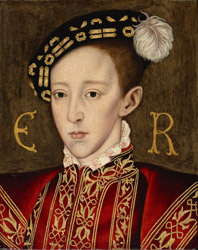The Coronation of Edward VI
Posted on
On 20th February 1547, the young king Edward VI was officially crowned. He was the third, and would prove to be the last, Tudor king of England.
His father, Henry VIII, had only died a few weeks earlier, and his mother Jane Seymour had died shortly after his birth. His next nearest relatives were his two half-sisters, Mary and Elizabeth, and then several cousins including Lady Jane Grey. While the king had been a sick man for many years, it must still have come as a shock to Edward to suddenly become king, he was only nine years old. Henry’s funeral was held on 16th February, and he was buried at Windsor next to Edward’s mother.
 Edward was young, he couldn’t lead his troops in to battle against the French (a guaranteed way to gain some popularity) or marry a beautiful princess with a rich dowry (a wedding was also a good way to cheer the people). His regency council, who had been named in Henry’s will, were quick to get him crowned as it gave both him and them legitimacy. While the organisation may have been rushed, the coronation itself was still a splendid display of Tudor wealth.
Edward was young, he couldn’t lead his troops in to battle against the French (a guaranteed way to gain some popularity) or marry a beautiful princess with a rich dowry (a wedding was also a good way to cheer the people). His regency council, who had been named in Henry’s will, were quick to get him crowned as it gave both him and them legitimacy. While the organisation may have been rushed, the coronation itself was still a splendid display of Tudor wealth.
The day before the coronation ceremony, Edward travelled through London, from the Tower to Westminster, where he frequently stopped to view the pageants that were put on display for him. This process was a traditional part of the process, it let the new king be seen by his subjects, while the displays showed everyone that England could really put on a show. The next day saw the ceremony itself, which was shortened so that it wouldn’t tire him out too much. But it was still the Archbishop of Canterbury, Thomas Cranmer, who officiated, and who encouraged Edward to continue the reformation of the church.
Edward was not the first boy-king in English history. Henry III and Richard II had been around the same age when they had inherited the throne, the uncrowned Edward V had been twelve years old, Edward III had been in his early teens, and Henry VI had been a toddler. However out of these five, three had been deposed and Henry III had faced the DeMontfort rebellion. Most of Edward III’s problems had come later on in his reign, but generally he had been a popular king.
Edward VI never lived long enough to show whether he could be popular like Edward III or potentially overthrown like Richard II and Henry VI. His reign was dominated by his uncle, Edward Seymour, and then John Dudley, Duke of Northumberland. England was crippled by expensive wars and then an economic crisis. Had he lived, perhaps he would have been able to find some middle ground with both Scotland and France, and created an economic policy to increase trade and bring wealth back to the country. Or perhaps he would have failed miserably and been booted out by his subjects.
In the end Edward died aged fifteen, having never really ruled on his own.